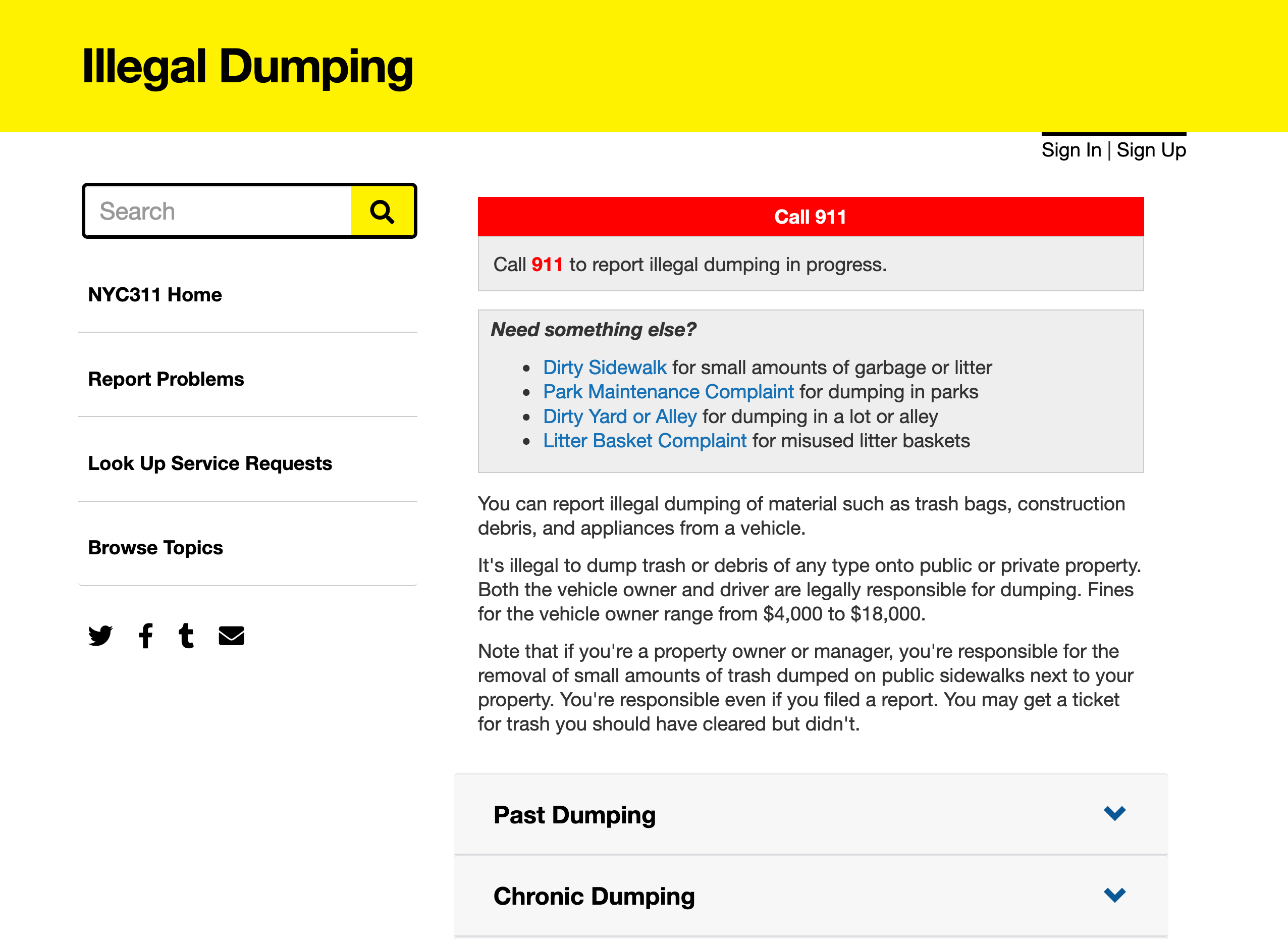March 7, 2022
New York City Department of Sanitation Starts Making Use of 311 Data
After a state audit revealed DSNY was not utilizing the millions of 311 complaints it receives to find trends, the department launched a program focused on identifying and solving chronic illegal dumping.
ABOUT PROJECT >
Nicole Taylor was sitting on her front porch in Hollis, Queens, when she
couldn’t believe her eyes. A car pulled up to the red light in front of her house,
and the driver threw a full garbage bag out of the window and onto the ground.
Taylor had seen large piles of illegally abandoned waste throughout her neighborhood
– construction materials, car fluid, tires, and household trash – but this was the
first time she had witnessed someone in the act.
“It’s just baffling that people are so disrespectful [that they] feel like, ‘I can do
whatever I want to this planet.’”
Vincent Gragnani, a spokesperson for the Department of Sanitation said that while city
residents have been using 311 to report illegal dumping for years, changes to their
internal systems, like adding the “Illegal Dumping” categories, can be “useful in
determining a course of action.”
“A report of chronic illegal dumping could trigger not only a request for cleanup, but
also put the site on our radar for ongoing enforcement,” said Gragnani. He pointed to a
couple of examples of chronic sites the department has been able to identify thanks to
the 311 changes. Like stretches of Gateway Drive near the Gateway Center shopping mall
in East New York, and several streets in what’s colloquially referred to as “The Hole”
– a desolate several blocks nestled between Ozone Park and East New York.
The Hole is a notorious illegal dumping ground that has battled the issue for years. Gabriel
Neves is a freelance writer who recently featured “The Hole” in an article for Untapped
New York. He said when he last visited in August, before the changes to 311, it was filled
with “trash and debris.”
“I have heard stories about people saying that the Department of Sanitation has always mentioned
they'd be cleaning things up in the area but nothing ever really gets put into action,” said Neves.
The department of sanitation responded saying while they have been aware of the illegal dumping issues at
“The Hole,” the new system is helping them “track specific locations and times to address” the problem.
Two years ago, the state comptroller conducted an audit of the agency’s effectiveness in keeping
New York City streets clean. It found that DSNY officials were not “identifying problem areas or trends.”
The report stated that one reason was the department was not making use of the readily available 311 data.
Since 2018, the agency has received over one million complaints and requests from residents through 311.
While roughly half of those requests are regarding waste and recycling collections, more than 200,000 feature
complaints about dirty conditions, with the location of the complaint and the time it was recorded. In the audit,
the comptroller recommended sanitation officials start utilizing these records to “identify the root causes for
recurring dirty areas and develop solutions to address them, including seeking community, department, or
cross-agency engagements, where necessary.”
An analysis of 311 data shows that the department has recently made many changes to the data it collects from the
call center, like cleaning up the descriptions of complaints as well as adding the illegal and chronic dumping categories.
311 data show that since the sanitation department made changes in September of last year, it has received over 1,200
reports of chronic dumping.
99 Avenue, a mile-long road that runs along railroad tracks between Jamaica and Queens Village is the most recurring
address for “chronic dumping” in the 311 database. It goes right through Nicole Taylor’s neighborhood, and she has
filed several complaints about construction debris or household waste left along the isolated road. Taylor said the
Department of Sanitation usually is responsive, picking up the trash within a matter of weeks, but the trash keeps
reappearing in the same spots.
“It really puts a damper on wanting to be proud of your community, to say the least,” said Taylor. “This is why people
move out. They feel helpless and hopeless when they don’t see anything changing, they just say, ‘I need to get out.’”
She has started working with Abuela Neighborhood Maintenance to clean up the neighborhood and report illegal dumping to 311.
Taylor said she files a report to 311 at least once or twice a week.
Since the sanitation department launched its new “illegal dumping” 311 category, New Yorkers have filed almost 600
complaints of chronic dumping in Taylor’s community district – Queens 12 – making it the top community board for that category.
Taylor said she hopes more people will become aware of the epidemic of illegal dumping in New York, if not for the planet, then at
least for the children and families that live with it every day.
This story was written for Columbia's Writing with Data course. When another lead I was pursuing fell through, I turned this article around in two days in order to meet my deadline. While my writing was far from perfect for this class, I learned how to get over my writing paralysis and put pen to paper more quickly.
